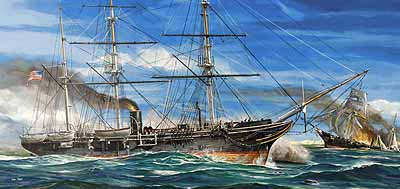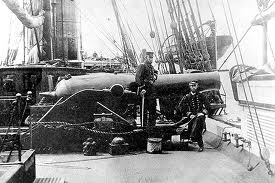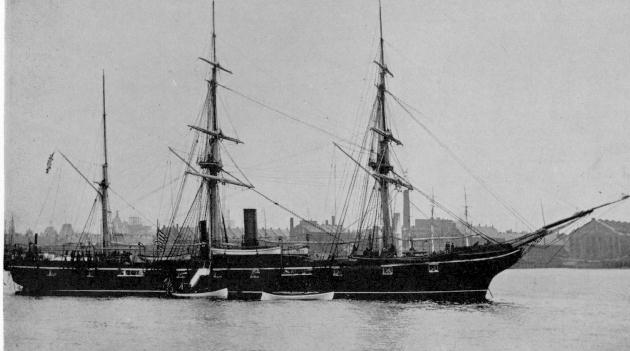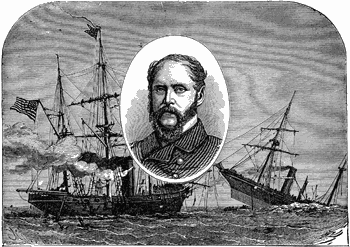A decade after the U.S.S. Kearsarge sank the Confederate cruiser Alabama, on June 19, 1864, the naming of the victorious ship became a matter of bitter dispute. Even the U.S. Navy believed, until recently, that the ship was named after a Mount Kearsarge in Warner, New Hampshire, but there are two mountains in New Hampshire known as Kearsarge, and different claimants contend that they suggested the name of the ship with different mountains in mind.

Henry McFarland, a Concord politician who published a newspaper there, claimed to have submitted the name for the Ossipee. He also insisted that he had named the Kearsarge, though, and that ran counter to the story told by the assistant secretary of the navy, Gustavus Fox. Fox’s wife was a New Hampshire native, and the daughter of Levi Woodbury; while her husband was at sea or in Washington, she often rusticated in North Conway. From her hotel she had a good view of the Mount Kearsarge that rises out of Bartlett and Chatham, and according to Fox she proposed naming one of the new gunboats after it, which he passed along to Secretary Welles.

Around 1875, when the Kearsarge had become famous and Mrs. Fox was dead, McFarland got wind of her story and disputed it. He ultimately enlisted Nathaniel Boutin, the president of the New Hampshire Historical Society, to certify his claim, most of which relied on the argument that the mountain in Carroll County was never called Kearsarge, and had no right to the name. Mr. Fox went to great lengths to prove that it always had been called Kearsarge, to the extent of soliciting affidavits from lifelong residents of Conway and Bartlett. He consulted a French Canadian priest who was familiar with the Abnaki dialect, who explained how two mountains might have been known by the same name, and he even sent operatives to England to dig through colonial maps. His box of evidence still sits in the historical society, but none of it satisfied McFarland or Boutin, both of whom lived closer to the mountain in Warner, to which they remained steadfastly loyal.
In fact, when the Kearsarge first went to sea the Carroll County mountain was well enough known by that name that northcountry guide books from at least 1849 identify it as Kearsarge. The biggest hotel in North Conway before the Civil War — the one where Mrs. Fox probably stayed — was called the Kearsarge House, after the mountain that loomed before it. Fox’s claim was perfectly plausible, besides which he had the best opportunity to convey his wife’s idea to the secretary of the navy, Gideon Welles. For his part, Welles could not remember having discussed the issue with anyone else. McFarland later claimed that his letter suggesting the name had been addressed to Fox himself, as though insinuating that the assistant secretary had misappropriated the idea, but even if he did submit the suggestion to someone, it was more likely Fox whose mention of it gave the ship its name.

That did not stop other people from assuming or insisting that the honor belonged to the Merrimack County mountain. Investors in a hotel on that mountain called it the Winslow House, to associate it with Captain John Winslow, who commanded the Kearsarge during its battle with the Alabama, and Winslow’s family used a boulder from Mount Kearsarge as Captain Winslow’s gravestone. In 1915 a Baptist minister named Joseph Gilmore testified under oath that he had named the Kearsarge for the Warner mountain himself, after his father, the governor of New Hampshire, asked him to supply some local Indian names for the vessels under construction in Portsmouth; unfortunately, Gilmore’s father was not elected governor until more than a year after the Kearsarge set sail on its first cruise.
The name of the Carroll County mountain has twice been changed to accommodate advocates of the Warner mountain. Cartographers labeled it Mount Pequawket for a time, but no one in the northcountry would buy that, so in 1958 it was officially designated Kearsarge North. To this day, however, it is still known simply as Kearsarge by all who live in the vicinity. The village at the foot of that mountain has also been called Kearsarge since before the Civil War, and when the navy launched an aircraft carrier under that name the Kearsarge village postmaster was invited to the christening. William Marvel lives in South Conway. .
 Captain
Winslow of the U.S.S Kearsarge, depicting the sinking of The Alabama.
Captain
Winslow of the U.S.S Kearsarge, depicting the sinking of The Alabama.Editors Note: Pictures courtesy of Google Search. We trust Mr. Marvel will not take issue with Bartlett Historical Website reprinting his article. You might enjoy Mr. Marvel's book on this subject:
While you are there check out his other books, Andersonville is one of my favorites.
